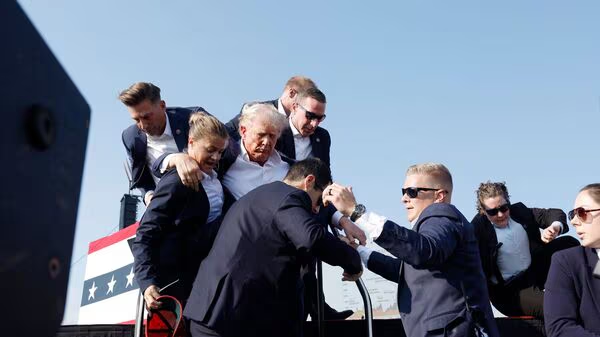Trump Survives Assassination Attempt at Rally
Date: [16july2024]
Location: Western Pennsylvania
In a shocking turn of events, former President Donald Trump narrowly escaped an assassination attempt during a campaign rally in western Pennsylvania on Saturday. This alarming incident, which unfolded while Trump was addressing his supporters, has brought the issue of political violence and the deepening polarization in the United States into sharp focus.
Table of Contents
Details of the Incident
As Trump delivered his speech to an enthusiastic crowd, a gunman positioned on a nearby rooftop opened fire. The chaos that ensued could have led to a tragic loss of life. However, thanks to the quick and decisive actions of Secret Service agents, the suspect was apprehended almost immediately, averting what could have been a catastrophic outcome.
Eyewitnesses reported a scene of chaos as attendees scrambled for safety, but remarkably, Trump himself remained unharmed. Thankfully, no injuries were reported among the crowd, which underscored the effectiveness of the security measures in place, despite the apparent vulnerability exposed by the incident.
This assassination attempt is not merely an isolated event but a troubling reflection of the current political climate in America. The extreme polarization that has characterized recent years has created an environment where such violence seems alarmingly possible.
The Broader Context
The assassination attempt on Trump is emblematic of a larger crisis facing the United States—a nation increasingly divided along ideological lines. Over the past few years, political discourse has deteriorated, with extreme rhetoric becoming more commonplace. Social media, while a tool for connection, has also served as a breeding ground for misinformation and animosity, amplifying tensions.
Trump’s presidency itself was marked by controversy and division, and his continued presence in the political arena has kept these divisions at the forefront of national discussions. His rallies often draw passionate supporters, but they can also attract vehement opposition, leading to heightened risks during public events.
Political Polarization in America
Political polarization in the United States is not a new phenomenon, but it has escalated significantly in recent years. According to various studies, Americans are increasingly viewing members of the opposing party as adversaries rather than fellow citizens with differing opinions. This shift has contributed to a climate where political violence, unfortunately, becomes a more feasible option for some individuals.
The rhetoric used by public figures, including Trump, has often been incendiary, fueling emotions and, in some cases, leading individuals to take extreme actions. The assassination attempt underscores the urgent need for political leaders to take responsibility for their words and the potential consequences they may incite.
Reactions from Leaders and Authorities
In the aftermath of the incident, political leaders from both parties have condemned the attack. Expressions of solidarity and concern poured in from across the political spectrum, emphasizing the need for unity in the face of violence. President Joe Biden, along with numerous lawmakers, took to social media and press conferences to denounce the act and call for a peaceful political discourse.
Law enforcement and security agencies have also reacted swiftly, launching a thorough investigation into the motives and background of the assailant. Authorities are expected to review security protocols for future rallies and public events involving high-profile figures, recognizing the heightened risks that come with today’s political climate.
The incident has reignited discussions about the adequacy of security measures for political figures, especially in light of the increasing frequency of threats against them. With elections approaching, ensuring the safety of candidates and their supporters will undoubtedly be a top priority for authorities.
The Role of Media and Social Platforms
The media’s role in shaping public perception and discourse cannot be overlooked in this context. News outlets and social media platforms have a responsibility to report accurately and responsibly, avoiding the sensationalism that can escalate tensions. The coverage of events such as this attempted assassination must strike a balance between informing the public and not fueling further divisions.
Social media platforms are also grappling with the challenge of moderating content that can incite violence or spread misinformation. In the wake of this incident, there will likely be increased scrutiny on how these platforms manage political discourse and the potential impact it has on real-world events.
Implications for Future Elections
As the nation heads towards the next election cycle, the implications of this assassination attempt will resonate deeply within the political landscape. Candidates from all parties will need to navigate an increasingly fraught environment where public safety and political discourse are of paramount concern.
Campaign strategies may evolve as candidates assess the risks associated with public appearances and rallies. While direct engagement with supporters remains crucial, the need for heightened security and risk management will likely shape how politicians approach their campaign activities moving forward.
A Call for Unity and Dialogue
In light of this terrifying incident, there is a pressing need for a renewed commitment to unity and dialogue among Americans. Political leaders, activists, and citizens alike must work towards fostering a culture that promotes respectful discourse rather than division. Encouraging open conversations across the political spectrum is essential to healing the rifts that have developed over the years.
Community engagement initiatives and bipartisan efforts will play a vital role in mending the social fabric of the nation. It is crucial to create spaces where individuals can come together, share their perspectives, and find common ground, even amid profound differences.

Thank you for your sharing. I am worried that I lack creative ideas. It is your article that makes me full of hope. Thank you. But, I have a question, can you help me?